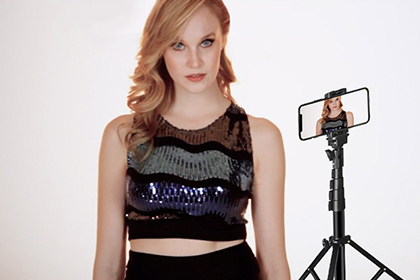
This is the first installment in a series to guide dancers through the audition process in a post covid world. One skill you will definitely need is how to self-tape for audition submissions. Dancers with agents have been submitting this way for a while, but what if you’re new or just breaking into the industry?
 In the words of Jim Keith, partner and president, The Movement Talent Agency (MTA), there are three very important things you must do if you want to book in today’s environment, ‘Learn how to self tape. Learn how to self tape, and finally, Learn how to self tape … and be able to turn it in very quickly.’
In the words of Jim Keith, partner and president, The Movement Talent Agency (MTA), there are three very important things you must do if you want to book in today’s environment, ‘Learn how to self tape. Learn how to self tape, and finally, Learn how to self tape … and be able to turn it in very quickly.’
Jim also explained that in Los Angeles, sometimes self-tape auditions are due in a matter of hours. In New York City, there can be a few days of lead time, but the sooner you can submit your audition, the better your odds of being seen. If you wait until the deadline, there’s a chance your submission won’t even be viewed. Submitting early is key.
It’s best to work on your self tape skills when you have down time. Train yourself before your dream job is posted. Here are some general guidelines for creating a strong submission:
You’ll need a tripod for your camera or iPhone. There are lots of options online, so shop around for a tripod that fits your budget. Many dancers and actors use a ring light so remember the light source should always be behind the camera facing you. Always shoot landscape, an important detail that's mentioned in most posted dance auditions.
Check what can be seen in the view finder. And then check after you shoot. Make sure the camera is not capturing any background distractions. Clear what you can in your location so the focus is on you. If weather permits, find a place to shoot outside. Simple backgrounds work best. You don’t want to get lost in a busy background of graffiti or lots of traffic.
Focus on good lighting and a quiet background. Make sure you stay in frame. If filming for a speaking role, shooting from your shoulders up is the best view. Remember, you can edit your final submission, so go ahead and film a few versions.
Speaking of editing, allow enough time to edit your video and create one complete video using iMovie or other video editing software. iMovie comes with the iPhone and it’s easy to use, so it’s a great place to start.
Remember … Always, always, always be sure to shoot in landscape mode from a low angle. Basically try to put the camera/iPhone at knee level and then tilt it up.
Allow time to watch what you’ve recorded. Are you in focus? Is your full body in the frame? If not, adjust your vantage point and try again.
Keep in mind your video will be watched from a computer or TV and you have to find a way to engage your audience to assure them you can engage an audience.
Think of the iPhone as your audience. You have to find a way to connect to the viewer of your self tape and that’s best done looking directly at the camera.
If you have time and skills, mute the recording and then add the music on a second track. That will delete any unwanted sounds like a car driving by, a dog barking, or sounds from a windy day.
If filming for a speaking role or slating yourself for the beginning of your submission, the best view is to shoot from your shoulders up. Slating is the industry term for introducing yourself in an audition. The exact information you provide in a slate will depend on what the casting team asks for. If not, then you should state your name and the role you’re submitting for.
Keep in mind that if your video submission has captured the attention of a casting director, it's important to make sure all your materials are up-to-date and easy to locate.
 Brandon Sierra, Agent/Director of LA Talent, McDonald Selznick Associates (MSA) gives this great advice. ‘You have to be on top of your materials more now than any other time before. Photos and footage must be current… Posting consistently on your social media platforms has always been important. But with a lack of in person opportunities, hiring authorities are really relying heavily on the fact that your materials are up to speed and fully represent you and your abilities as a talent.’
Brandon Sierra, Agent/Director of LA Talent, McDonald Selznick Associates (MSA) gives this great advice. ‘You have to be on top of your materials more now than any other time before. Photos and footage must be current… Posting consistently on your social media platforms has always been important. But with a lack of in person opportunities, hiring authorities are really relying heavily on the fact that your materials are up to speed and fully represent you and your abilities as a talent.’
There are lots of moving parts to online submissions. Watch for more updates to help you present yourself in the best possible way. In the meantime, practice, practice, practice until filming and editing your self tape videos represent the best version of you and your abilities. Prepare yourself now so when the right job comes along, you’ll know just what to do!
Remember, this is a short list of self tape tips and tricks. The best way to teach yourself how to produce a great audition video is to practice over and over until it becomes second nature.
For more Tools 4 Auditions, click here.
